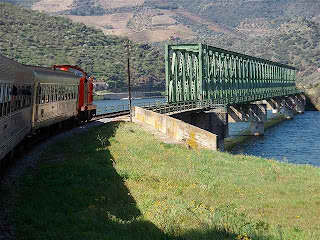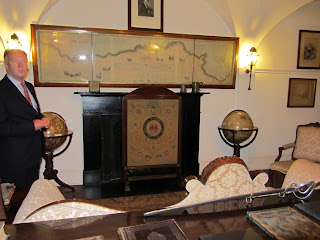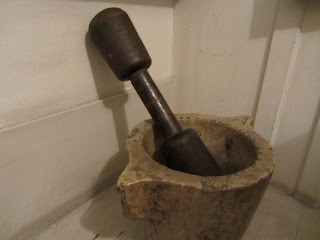The Douro Line runs between Porto and Pocinho, a town approximately 20 kilometers from the Spanish border. The line is 160 kilometers long thanks to the enabling capabilities of 26 tunnels and 30 bridges along its path. The line was put into service in 1887 -- after a 12-year construction effort -- in order to speed up the carriage of Port wine, other goods, and passengers between Porto and the stops along the way. At its inception, the journey from Pocinho to Porto was cut from 12 days to 5 hours.
Our day in Vila de Gaia had begun with tours of the Taylor's and Graham's Port Lodges, followed by a masterful Port wine Masterclass led by Paul Symington, CEO of Symington Family Estates, and lunch at the Symington Family Estates Executive Offices. We were scheduled to travel by train to Quinto do Vesuvio where we would be spending Friday and Saturday nights. With all of our scheduled activities, and the interest that these generated among our team members, we were perilously close to missing the train for which we had reservations. We said hurried goodbyes and got into our waiting rides for a pell mell trip through Oporto streets to the Campanhã train station.
We arrived at the station and hurriedly disembarked, snatched up our luggage and headed for the platform. One of the Symington staffers had ridden along with us to ensure that we went directly to the appropriate platform. We helped each other get the luggage onto the train. I cursed my wife under my breath (she has never met a jumbo-sized suitcase that she doesn't like) as I struggled to get her "weekender" aboard the train. There were no luggage racks inside the passenger compartment so we stacked the suitcases in the loading areas outside the compartment (There was some overhead space within the compartment for small items.). We made our way into the carriage and plunked ourselves into the seats that had not already been claimed by early-arriving passengers. Shortly after we collapsed exhausted into our individual seats, the train moved out.
Our schedule called for us to leave Porto at 3:20 pm and travel to Régua, making a number of stops along the way. We would arrive at Régua at 5:05 pm at which time we would be told whether we would have to change out trains for the remainder of the journey to Vesuvio, the stop for Quinto do Vesuvio. We were scheduled to leave Régua at 5:30 pm and arrive at Vesuvio at 6:39 pm where Paul Symington -- who had gone ahead by car to make arrangements for our arrival -- would meet us.
It took me a while to stop breathing heavily (after my encounter with my wife's luggage) and take stock of my surroundings. Having boarded the train in a rush, I had not had the luxury of being strategic in my seat selection. I was facing away from the direction of travel and had limited visibility of the scenery to my right and even less so on my left. So here I was, beginning one of the most scenic train rides in the world, and having no view. A punch in the gut. I would have to figure something out. But not now. I needed more resuscitation time. I did have an excellent view of our carriage and noted that it seemed occupied by locals with members of the Decanter team sprinkled randomly throughout the carriage.
For the first (what I found out later to be) 60 kilometers, the scenery was pedestrian but this all changed when the line met the river at Mosteiro where it travels west to east along the river on its north bank. We were sitting on the side of the train furthest from the river and saw everyone looking out and up. My backward facing seat was not getting the job done for me. After a few kilometers of fleeting glances of this scenery as it fled into the distance, I got out of my seat and went on the platform outside the passenger compartment in order to gain an unobstructed view. This was a great move until I found out that this was also the access point for the onboard bathroom which, when flushed, flooded on to the floor inside and outside the bathroom. I beat a hasty retreat.
There were a number of stops between Mosteiro and Régua and, at each stop, people would disembark and be replaced by new passengers. But between each stop we were treated to kilometer after kilometer of beautifully terraced vineyards rising from the river's edge and working their way up the slopes to the tree line; and if the hill were below a certain height, along its crest. Where vineyards were not planted, olive groves abounded. In many cases they were interspersed. In cases where vines or olive trees were not planted, the tree line reached down to the waters edge. Or a forest of rocks. At some points along the way a roadway paralleled the river. The river itself is fairly tranquil and its even disposition and height sets it in stark contrast to the sometimes rocky, sometimes craggy, sometimes terraced hillsides that frame it along its entire length.
At Régua we found out that we would not have to change trains after all (This was a relief as I wanted to delay re-tangling with my wife's "weekender" for as long as possible.). Régua had been a very important stop in the olden days as the town had been the capital of the Port wine trade. Another important stop along the way is Pinhão. This station is decorated with blue and white glazed tiles (azauelos) which depict local river and harvest scenes.
 |
| Source: Railbrit.co.uk |
 |
| Source: Railbrit.co.uk |
 |
| Source: Railbrit.co.uk |
Shortly after leaving the Alegria stop, we see an imposing granite formation, the signature of the Valeria Canyon. The longest tunnel on the line (712 m) had to be blasted through the granite to allow passage of the rail line. Passage through this tunnel gets us into Douro Superior, the region that is home to Quinta do Vesuvio. And four stops later we arrive at our destination. We are the only ones to get off at the station. And then it hits me. This stop is expressly for the use of this estate. Paul is there to meet us. He has shed his corporate trappings and is now attired in blue jeans and a land rover. The look of gentleman farmer fits him. He welcomes us and then sets about loading our luggage into the vehicles. We rush in to help.
Oh and about the trip. It is the most scenic train ride I have ever taken.



































